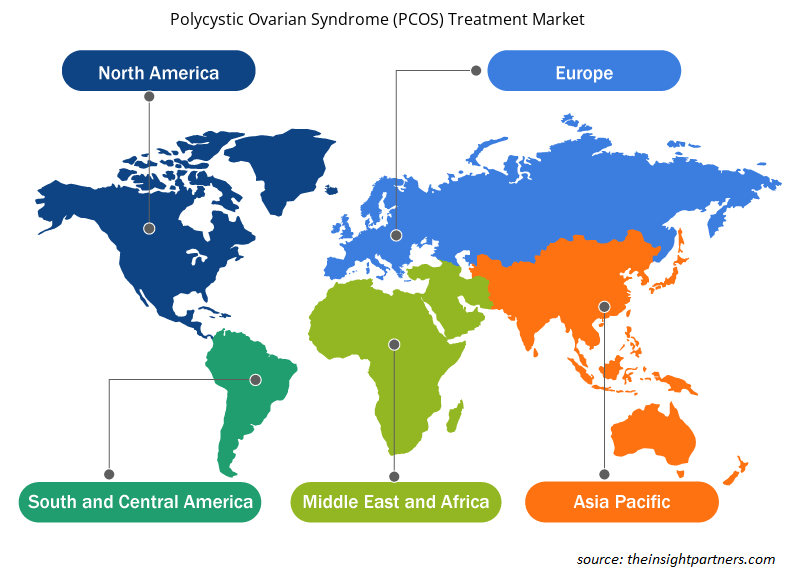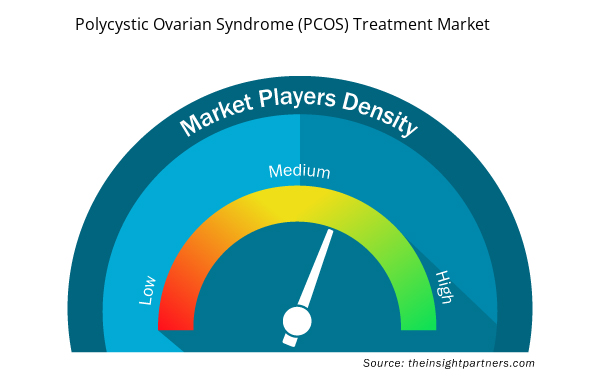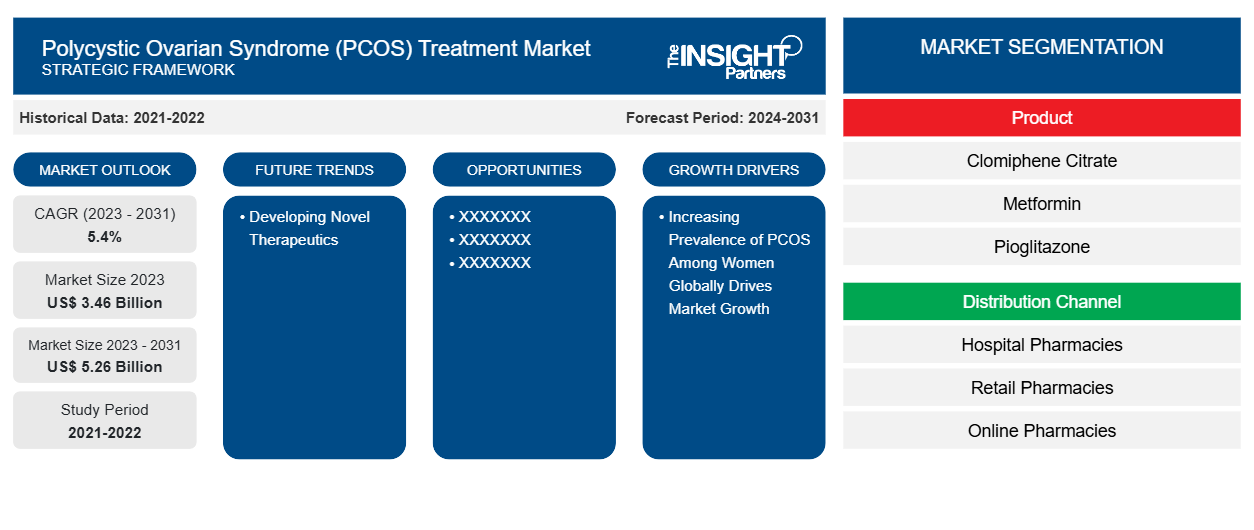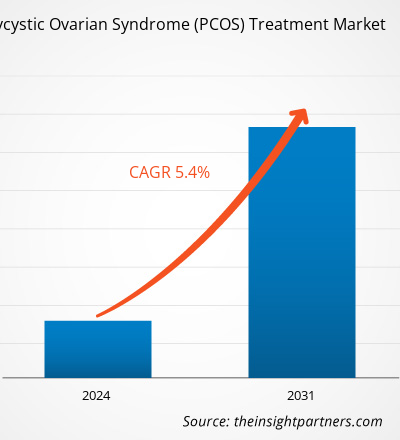多囊卵巢综合征 (PCOS) 治疗市场预测有助于该市场的利益相关者概述其增长战略。预计该市场将从 2023 年的 34.6 亿美元增长到 2031 年的 52.6 亿美元;预计 2023-2031 年的复合年增长率为 5.4%。
全球 PCOS 患病率的上升,加上 PCOS 治疗医疗支出的大幅增加,是推动多囊卵巢综合征 (PCOS) 治疗市场增长的因素。例如,美国约有 600 万女性患有 PCOS,这是一种常见的激素失衡疾病。它会增加患子宫内膜癌、高血压、2 型糖尿病、不孕症和中风等多种疾病的风险。此外,内分泌学会估计,多囊卵巢综合征 (PCOS) 是影响育龄女性最常见的激素紊乱,2020 年全国范围内的诊断和治疗费用将达到 80 亿美元。
在预测期内,开发新型疗法将带来新的多囊卵巢综合征 (PCOS) 治疗市场趋势。
增长动力:
全球女性 PCOS 患病率不断上升,推动多囊卵巢综合征 (PCOS) 治疗市场增长
多囊卵巢综合征 (PCOS) 是一种常见的女性内分泌疾病,由多种因素引起。根据世界卫生组织 (WHO) 的数据,PCOS 影响着约 8-13% 的育龄女性。在全球范围内,PCOS 是导致无排卵的最常见原因,也是导致不孕的主要原因。此外,约 70% 的 PCOS 女性仍未得到诊断。不健康的饮食生活和一些环境因素会导致 PCOS。肥胖是 PCOS 的主要风险因素,因为体内过多的脂肪会破坏激素水平和胰岛素敏感性,从而导致该病的发展。随着全球肥胖疫情的加剧,越来越多的女性面临患上 PCOS 的风险。根据世界肥胖联盟发布的《2022 年世界肥胖地图集》,到 2030 年,全球将有超过 10 亿人受到肥胖的影响,其中包括每五名女性中就有一名。
此外,PCOS 患病率的不断上升也导致对有效治疗方案的需求不断增长。各种药物和非药物 PCOS 治疗方法可用于调节激素水平、改善胰岛素敏感性以及解决导致 PCOS 的其他潜在因素。因此,全球女性 PCOS 患病率的不断上升推动了多囊卵巢综合征 (PCOS) 治疗市场的增长。
克制:
FDA 批准的 PCOS 专用药物供应有限,阻碍了多囊卵巢综合征 (PCOS) 治疗市场的发展
美国食品药品管理局 (FDA) 批准的专门用于治疗多囊卵巢综合征 (PCOS) 相关的复杂症状和潜在激素失衡的药物数量有限。尽管 PCOS 患病率很高,对女性健康、生育能力和生活质量有重大影响,但 FDA 批准用于治疗这种疾病的药物选择(标外用药)相对较少。缺乏 FDA 批准的药物对寻求有效且基于证据的 PCOS 治疗的医疗保健提供者和患者来说是一个挑战。虽然标外使用某些药物(如口服避孕药、胰岛素增敏剂和抗雄激素)在治疗 PCOS 症状方面很常见,但缺乏专门的治疗方法限制了全面治疗这种疾病的能力。因此,FDA 批准的专门用于 PCOS 的药物数量有限,限制了多囊卵巢综合征 (PCOS) 治疗市场的增长。
定制此报告以满足您的需求
您可以免费定制任何报告,包括本报告的部分内容、国家级分析、Excel 数据包,以及为初创企业和大学提供优惠和折扣
- 获取此报告的关键市场趋势。这个免费样品将包括数据分析,从市场趋势到估计和预测。
报告细分和范围:
多囊卵巢综合征 (PCOS) 治疗市场分析已通过考虑以下部分进行:产品和分销渠道。
按产品划分,多囊卵巢综合征 (PCOS) 治疗市场分为克罗米芬柠檬酸盐、二甲双胍、吡格列酮、口服避孕药等。二甲双胍部分在 2023 年占据最大市场份额。此外,克罗米芬柠檬酸盐部分预计在预测期内实现最高复合年增长率。
按分销渠道划分,多囊卵巢综合征 (PCOS) 治疗市场分为医院药房、零售药房和在线药房。2023 年,医院药房占据了多囊卵巢综合征 (PCOS) 治疗市场的最大份额,预计在预测期内将实现最高的复合年增长率。
区域分析:
从地理分布上看,多囊卵巢综合征 (PCOS) 治疗市场报告的范围包括北美、欧洲、亚太地区、南美和中美以及中东和非洲。2023 年,北美占据了最大的市场份额。最新医疗器械技术的采用日益广泛、PCOS 患病率不断上升以及主要参与者不断增加的产品创新,推动了北美多囊卵巢综合征 (PCOS) 治疗市场规模的不断增长。根据美国卫生与公众服务部的数据,PCOS 是美国女性不孕的常见原因,影响了约 6% 至 12%(约 500 万)的美国育龄女性。根据 2023 年 7 月发表在《美国妇产科杂志》上的研究“多囊卵巢综合征诊断的发病率、患病率和趋势”,美国 PCOS 的发病率为每年每 10,000 人 42.5 例。此外,该国的各个组织都提供全面的评估,提高认识,并专注于与 PCOS 相关的研究。例如,加州大学旧金山分校生殖健康中心正在积极研究 PCOS 的病因。因此,PCOS 的高患病率以及专注于研究和宣传的组织的存在有利于多囊卵巢综合征 (PCOS) 治疗市场的增长。
多囊卵巢综合征 (PCOS) 治疗市场区域洞察
Insight Partners 的分析师已详尽解释了预测期内影响多囊卵巢综合征 (PCOS) 治疗市场的区域趋势和因素。本节还讨论了北美、欧洲、亚太地区、中东和非洲以及南美和中美洲的多囊卵巢综合征 (PCOS) 治疗市场细分和地理分布。

- 获取多囊卵巢综合征 (PCOS) 治疗市场的区域特定数据
多囊卵巢综合征 (PCOS) 治疗市场报告范围
| 报告属性 | 细节 |
|---|---|
| 2023 年的市场规模 | 34.6亿美元 |
| 2031 年市场规模 | 52.6亿美元 |
| 全球复合年增长率(2023 - 2031) | 5.4% |
| 史料 | 2021-2022 |
| 预测期 | 2024-2031 |
| 涵盖的领域 | 按产品
|
| 覆盖地区和国家 | 北美
|
| 市场领导者和主要公司简介 |
|
多囊卵巢综合征 (PCOS) 治疗市场参与者密度:了解其对业务动态的影响
多囊卵巢综合征 (PCOS) 治疗市场正在快速增长,这得益于终端用户需求的不断增长,而这些需求又源于消费者偏好的不断变化、技术进步以及对产品优势的认识不断提高等因素。随着需求的增加,企业正在扩大其产品范围,进行创新以满足消费者的需求,并利用新兴趋势,从而进一步推动市场增长。
市场参与者密度是指在特定市场或行业内运营的企业或公司的分布情况。它表明在给定市场空间中,相对于其规模或总市场价值,有多少竞争对手(市场参与者)存在。
在多囊卵巢综合征 (PCOS) 治疗市场运营的主要公司有:
- 赛诺菲公司
- 默克公司,
- 诺华公司,
- 迈兰,
- 武田药品工业株式会社
- 雅培,
免责声明:上面列出的公司没有按照任何特定顺序排列。

- 获取多囊卵巢综合征 (PCOS) 治疗市场顶级关键参与者概览
行业发展和未来机遇:
根据公司新闻稿,多囊卵巢综合征 (PCOS) 治疗市场主要参与者的一些战略发展如下:
- 2023 年 4 月,Celmatix 启动了新型 PCOS 药物项目。该公司公布了其最新的治疗方案,针对中枢神经系统 (CNS) 以外的褪黑激素受体。该治疗药物将填补针对各种女性健康状况的有效一线疗法的关键市场空白,从 PCOS 开始,并可能扩展到子宫内膜异位症和更年期症状。
- 2022 年 1 月,Celmatix Inc. 宣布与 Evotec 的五年多靶点联盟取得了里程碑式的成就。Evotec 和拜耳股份公司推动了以 Celmatix 确定的新型药物靶点为中心的 PCOS 药物项目进入了成功识别阶段。
竞争格局和重点公司:
赛诺菲公司、默克集团、诺华、迈兰、武田制药有限公司、雅培、梯瓦制药、Salix Pharmaceuticals Inc、阿斯利康和辉瑞公司是多囊卵巢综合征 (PCOS) 治疗市场报告中介绍的知名公司。这些公司专注于开发新技术、升级现有产品并扩大其地理覆盖范围,以满足全球日益增长的消费者需求。
- 历史分析(2 年)、基准年、预测(7 年)及复合年增长率
- PEST 和 SWOT 分析
- 市场规模价值/数量 - 全球、区域、国家
- 行业和竞争格局
- Excel 数据集


- Electronic Shelf Label Market
- Drain Cleaning Equipment Market
- Aquaculture Market
- Nuclear Waste Management System Market
- 3D Mapping and Modelling Market
- Sexual Wellness Market
- Artificial Intelligence in Defense Market
- Skin Graft Market
- Analog-to-Digital Converter Market
- Emergency Department Information System (EDIS) Market

Report Coverage
Revenue forecast, Company Analysis, Industry landscape, Growth factors, and Trends

Segment Covered
This text is related
to segments covered.

Regional Scope
North America, Europe, Asia Pacific, Middle East & Africa, South & Central America

Country Scope
This text is related
to country scope.
常见问题
Factors such as the increasing prevalence of polycystic ovary syndrome (PCOS) among women globally and increasing government initiatives and support for research in the field of reproductive health propel the polycystic ovarian syndrome (PCOS) treatment market growth. However, the limited availability of FDA-approved medications specifically for PCOS hamper the growth of the market.
Polycystic Ovary Syndrome (PCOS) is a hormonal disorder that causes enlarged ovaries with cysts on their outer edges. Some symptoms of PCOS include excess hair growth, acne, missed or irregular menstrual periods, infertility, and weight gain.
The polycystic ovarian syndrome (PCOS) treatment market was valued at US$ 3.46 billion in 2023.
The polycystic ovarian syndrome (PCOS) treatment market majorly consists of the players, including Sanofi SA, Merck KGaA, Novartis, Mylan, Takeda Pharmaceutical Company Ltd, Abbott, Teva Pharmaceuticals, Salix Pharmaceuticals Inc, AstraZeneca, and Pfizer Inc
The market, by distribution channel, is categorized into hospital pharmacies, retail pharmacies, and online pharmacies. The hospital pharmacies segment held the largest polycystic ovarian syndrome (PCOS) treatment market share in 2023, and it is anticipated to register the highest CAGR during the forecast period.
The polycystic ovarian syndrome (PCOS) treatment market is expected to be valued at US$ 5.26 billion in 2031.
By product, the market is segmented into clomiphene citrate, metformin, pioglitazone, oral contraceptives, and others. The metformin segment held a larger polycystic ovarian syndrome (PCOS) treatment market share in 2023. Further, the clomiphene citrate segment is anticipated to register a faster CAGR during the forecast period.
Trends and growth analysis reports related to Life Sciences : READ MORE..
The List of Companies - Polycystic Ovarian Syndrome (PCOS) Treatment Market
- Sanofi SA
- Merck KGaA
- Novartis
- Mylan
- Takeda Pharmaceutical Company Ltd
- Abbott
- Teva Pharmaceuticals
- Salix Pharmaceuticals, Inc
- AstraZeneca
- Pfizer Inc
The Insight Partners performs research in 4 major stages: Data Collection & Secondary Research, Primary Research, Data Analysis and Data Triangulation & Final Review.
- Data Collection and Secondary Research:
As a market research and consulting firm operating from a decade, we have published and advised several client across the globe. First step for any study will start with an assessment of currently available data and insights from existing reports. Further, historical and current market information is collected from Investor Presentations, Annual Reports, SEC Filings, etc., and other information related to company’s performance and market positioning are gathered from Paid Databases (Factiva, Hoovers, and Reuters) and various other publications available in public domain.
Several associations trade associates, technical forums, institutes, societies and organization are accessed to gain technical as well as market related insights through their publications such as research papers, blogs and press releases related to the studies are referred to get cues about the market. Further, white papers, journals, magazines, and other news articles published in last 3 years are scrutinized and analyzed to understand the current market trends.
- Primary Research:
The primarily interview analysis comprise of data obtained from industry participants interview and answers to survey questions gathered by in-house primary team.
For primary research, interviews are conducted with industry experts/CEOs/Marketing Managers/VPs/Subject Matter Experts from both demand and supply side to get a 360-degree view of the market. The primary team conducts several interviews based on the complexity of the markets to understand the various market trends and dynamics which makes research more credible and precise.
A typical research interview fulfils the following functions:
- Provides first-hand information on the market size, market trends, growth trends, competitive landscape, and outlook
- Validates and strengthens in-house secondary research findings
- Develops the analysis team’s expertise and market understanding
Primary research involves email interactions and telephone interviews for each market, category, segment, and sub-segment across geographies. The participants who typically take part in such a process include, but are not limited to:
- Industry participants: VPs, business development managers, market intelligence managers and national sales managers
- Outside experts: Valuation experts, research analysts and key opinion leaders specializing in the electronics and semiconductor industry.
Below is the breakup of our primary respondents by company, designation, and region:

Once we receive the confirmation from primary research sources or primary respondents, we finalize the base year market estimation and forecast the data as per the macroeconomic and microeconomic factors assessed during data collection.
- Data Analysis:
Once data is validated through both secondary as well as primary respondents, we finalize the market estimations by hypothesis formulation and factor analysis at regional and country level.
- Macro-Economic Factor Analysis:
We analyse macroeconomic indicators such the gross domestic product (GDP), increase in the demand for goods and services across industries, technological advancement, regional economic growth, governmental policies, the influence of COVID-19, PEST analysis, and other aspects. This analysis aids in setting benchmarks for various nations/regions and approximating market splits. Additionally, the general trend of the aforementioned components aid in determining the market's development possibilities.
- Country Level Data:
Various factors that are especially aligned to the country are taken into account to determine the market size for a certain area and country, including the presence of vendors, such as headquarters and offices, the country's GDP, demand patterns, and industry growth. To comprehend the market dynamics for the nation, a number of growth variables, inhibitors, application areas, and current market trends are researched. The aforementioned elements aid in determining the country's overall market's growth potential.
- Company Profile:
The “Table of Contents” is formulated by listing and analyzing more than 25 - 30 companies operating in the market ecosystem across geographies. However, we profile only 10 companies as a standard practice in our syndicate reports. These 10 companies comprise leading, emerging, and regional players. Nonetheless, our analysis is not restricted to the 10 listed companies, we also analyze other companies present in the market to develop a holistic view and understand the prevailing trends. The “Company Profiles” section in the report covers key facts, business description, products & services, financial information, SWOT analysis, and key developments. The financial information presented is extracted from the annual reports and official documents of the publicly listed companies. Upon collecting the information for the sections of respective companies, we verify them via various primary sources and then compile the data in respective company profiles. The company level information helps us in deriving the base number as well as in forecasting the market size.
- Developing Base Number:
Aggregation of sales statistics (2020-2022) and macro-economic factor, and other secondary and primary research insights are utilized to arrive at base number and related market shares for 2022. The data gaps are identified in this step and relevant market data is analyzed, collected from paid primary interviews or databases. On finalizing the base year market size, forecasts are developed on the basis of macro-economic, industry and market growth factors and company level analysis.
- Data Triangulation and Final Review:
The market findings and base year market size calculations are validated from supply as well as demand side. Demand side validations are based on macro-economic factor analysis and benchmarks for respective regions and countries. In case of supply side validations, revenues of major companies are estimated (in case not available) based on industry benchmark, approximate number of employees, product portfolio, and primary interviews revenues are gathered. Further revenue from target product/service segment is assessed to avoid overshooting of market statistics. In case of heavy deviations between supply and demand side values, all thes steps are repeated to achieve synchronization.
We follow an iterative model, wherein we share our research findings with Subject Matter Experts (SME’s) and Key Opinion Leaders (KOLs) until consensus view of the market is not formulated – this model negates any drastic deviation in the opinions of experts. Only validated and universally acceptable research findings are quoted in our reports.
We have important check points that we use to validate our research findings – which we call – data triangulation, where we validate the information, we generate from secondary sources with primary interviews and then we re-validate with our internal data bases and Subject matter experts. This comprehensive model enables us to deliver high quality, reliable data in shortest possible time.


 获取此报告的免费样本
获取此报告的免费样本